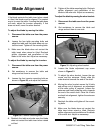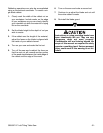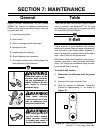
-26- G5959Z 12" Left-Tilting Table Saw
Blade Selection
Choosing the correct blade for the job is essential
for the safe and efficient use of your table saw.
Ignoring this important step could result in dam-
age to the saw and serious injury to the operator.
Documented below are the most common saw
blades and their uses.
1. Rip Blade: Used for cutting with the grain.
Rip blades have 30-40 teeth, flat-top ground
tooth profile and large gullets to allow for
large chip removal. See Figure 32.
Figure 32. Ripping blade.
3. Combination Blade: Used for cutting with
and across the grain. A compromise
between a rip blade and a cross-cut blade, a
combination blade will typically have 50-60
teeth, an alternate top bevel and flat or alter-
nate top bevel and raker tooth profile. The
teeth are arranged in groups of five. The gul-
lets are small and shallow within the groups
of five teeth, similar to a cross-cut blade;
then large and deep between the groups,
like a ripping blade. See Figure 34.
Figure 34. Combination blade.
2. Cross-cut Blade: Used for cutting across
the grain. Cross-cut blades have 60-80
teeth, alternate top bevel or steep alternate
top bevel tooth profiles, small hook angle
and a shallow gullet. See Figure 33.
Figure 33. Cross-cutting blade.
Figure 35. Plywood blade.
4. Plywood Blade: Used for cutting plywood or
veneers. Plywood blades have 60-80 teeth,
a steep alternate top bevel tooth profile and
very shallow gullet. See Figure 35.


















